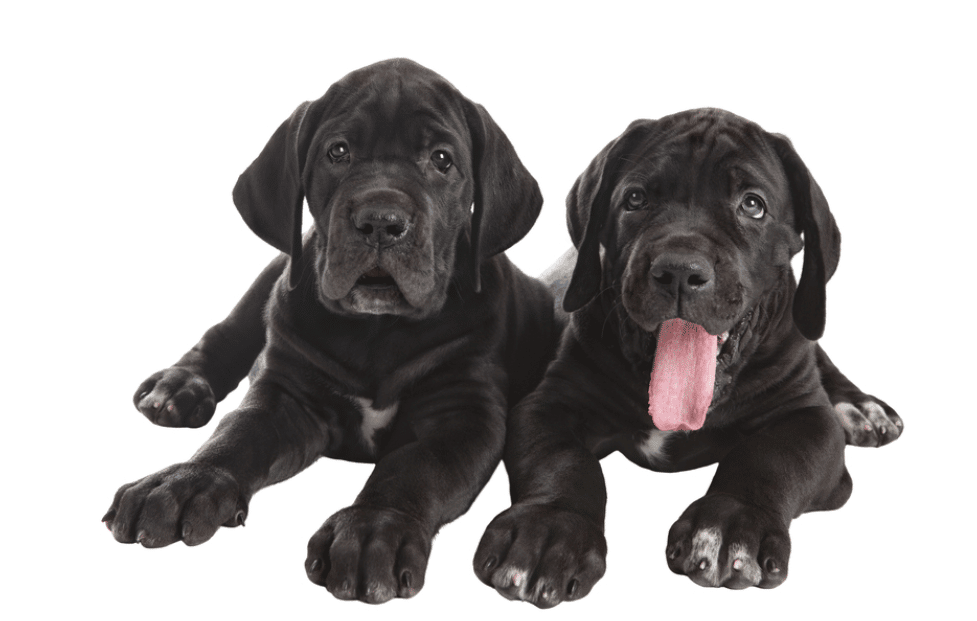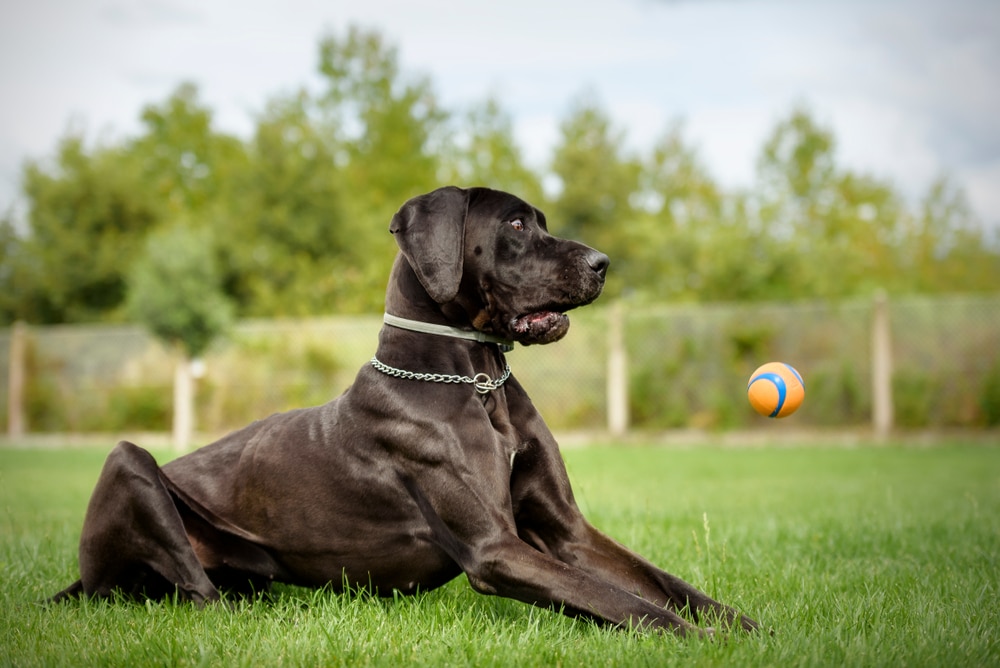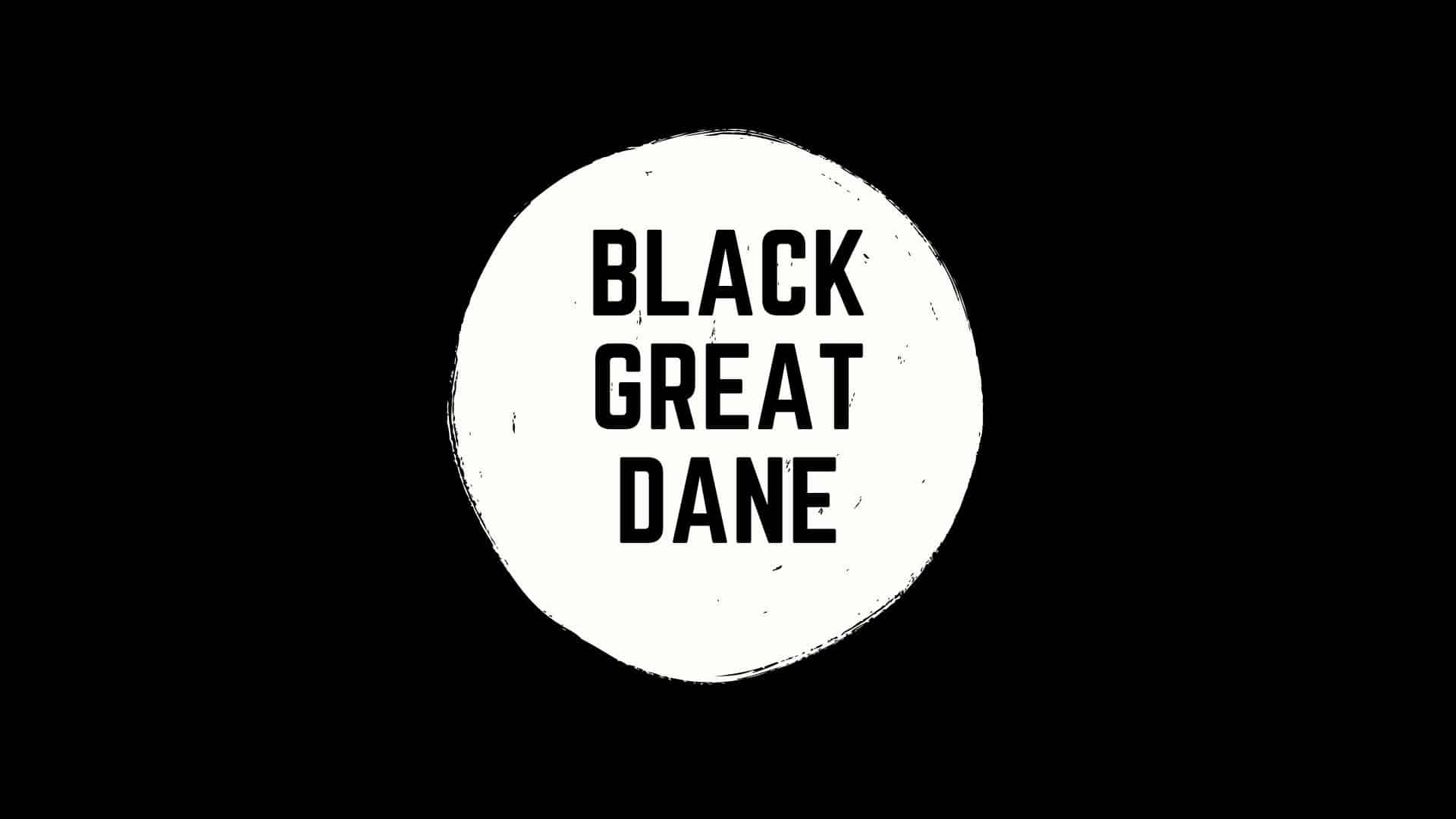“This post contains affiliate links, and I will be compensated if you make a purchase after clicking on my links.”
Last Updated on March 19, 2023
There is a certain aura that only Black Great Danes have. They have a rich black coat that depicts a dazzling and glossy shine, especially while in the sunlight. And thanks to their solid and shiny coat color, they can catch people’s attention even from afar and are highly sought after for dog show competitions.
In this article, you’ll learn everything you need to know about the majestic Black Great Dane. Continue reading below to find out more!
Black Great Dane Appearance

A Black Great Dane is a sight to behold and it’s easy to see why. Their sleek and shinny solid black coat makes them look majestic. Having colored (typically white) spots and markings on their chest and toes is pretty common. Although a Black Great Dane with no colored markings is always favored.
AKC Standards for Black Great Danes
The American Kennel Club (AKC) has strict standards for the Black Great Dane’s coat color and patterns. Below, we list down what this majestic Great Dane’s appearance should be according to AKC:
- The color shall be a glossy black.
- White markings on the chest or toes are not desirable.
Compared to other Great Dane colors, Black Great Danes, along with Blue Danes, only have two standards for their coat. However, this does not mean that these standards are easily met.
This is because white markings on the toes and chest are very common for Black Danes. Which is, according to breed standards, are not desirable. Although, subtle white markings are sometimes acceptable for dog shows, they can still affect a Great Dane’s chances in the championships.
Undoubtedly, if you wish to enter Great Dane dog shows, then a flawless and glossy Black Great Dane without any markings is what you should look for.
Mismarked Black Great Danes
As per breed standards, Black Great Danes shall be glossy black with no other markings. And generally, as per AKC’s standards, any Black Great Dane with big and noticeable markings can be considered a mismark and is not allowed in dog shows.
However, if you’re not looking for a Great Dane that can enter competitions and just want a family companion, then such markings are not going to be a problem.
Aside from white markings, mismarked Black Great Danes can also have other coat color markings such as fawn, brindle or blue. See below for a list of mismarked Black Danes.
1. Black and White Great Dane
A Black and White Great Dane is the most common Black Great Dane mismark. Usually, this mismark has a black coat with white markings on their chest and toes. And according to AKC standards, such Great Dane is not desirable and not fit to enter dog show competitions.
2. Brown and Black Great Dane
A Brown and Black Great Dane has a black coat but has fawn-colored markings, usually on their toes and chest.
3. Grey and Black Great Dane
A Gray and Black Great Dane is called as such but it really has a black coat and blue markings.
4. Black Merle Great Dane
The Black Merle Great Dane mismark has a merle pattern markings. This means, instead of plain-colored markings, they have a grey base color with black patches as toe and chest markings.
Mantle vs Mismarked Black Great Dane
Since the most common Black Great Dane mismark is the Black and White Great Dane, at times, irresponsible breeders disguise and sell them as Mantle Great Danes. So, you have to be careful.
But if you are familiar with the Mantle Great Dane‘s coat color and patterns, then it’s easy to identify which is which. While a common mismarked Black Great Dane and Mantle both have white markings on their chest and toes, a Mantle always has a white muzzle. Furthermore, a Mantle’s white blaze and the white stripe in between their eyes are also good identifiers.
Are Black Great Danes rare?
Black Great Danes are not rare. But it can be difficult to produce Black Danes with a shiny black coat with no markings at all.
As mentioned above, there are also a lot of instances where Black Great Danes have white markings on their toes and chest. However, sometimes, subtle white markings are accepted in dog shows, but this does not change the fact that a solid black coat color is the most preferred for a Black Great Dane.
Black Great Dane Puppies

All Black Great Danes are produced from breeding Black Great Danes together. But other than that, breeders can also produce them by breeding with other official Dane colors such as Harlequin, Blue and Mantle Great Danes.
Black Great Danes with white markings on their chests and toes are common results of breeding Harlequins with Harlequins or Black Danes with Harlequins.
Other than these acceptable breeding norms, Black Great Dane puppies are also produced from breeding with other unfavorable crosses. Breeding Black Danes with Brindles or Fawns can produce Black Dane puppies but such cross is considered unethical and forbidden because the risk of producing a lot of mismarks in a single litter is high.
Producing a litter with a lot of mismarks can be a problem because the chances of having puppies with health problems become higher. That’s why it’s important to only buy from responsible breeders who practice ethical breeding.
Health concerns
Diseases are always a problem for large breeds. If you are a Great Dane owner, you might know that the dog is predisposed to a number of health concerns.
A Black Great Dane can suffer from problems like cancer and develop lumps or tumors in the legs or anywhere in the body. It can also suffer from Bloat, which is another common occurrence with the breed, and if not prevented, can turn into a fatal condition. Furthermore, it can also develop Cardiomyopathy and due to their size, can suffer from weak joints.
On the bright side, Black Great Danes do not suffer from health problems due to their coat colors, unlike other coat colors like Harlequins who can suffer from canine deafness.
Grooming and Diet
As per the breed standards, you have to keep a Black Great Dane’s coat shiny. To ensure this happens, you have to take grooming and their diet seriously.
Regular brushing and bathing them once every fortnight will help them maintain a shiny coat and reduce shedding as well.
Other than grooming, a proper and balanced diet also makes a Great Dane’s coat and skin healthy. If you notice that your Dane is experiencing dry skin and excessive shedding, it might not get all the nutrients it needs.
Ensure to feed your Dane with high quality dry or wet dog food. If you notice no improvement in their skin and coat condition, switching to raw diet and/or adding supplements to their food are your other options.
Of course, a proper diet doesn’t only keep the Great Dane’s coat shinny but ensures the overall health of the dog.
Elevated feeders
With such an intimidating size and presence, sometimes, eating from a bowl on the floor can be difficult for a Great Dane. Hence, the need for elevated feeders.
However, elevated feeders are not a necessity, per se. You only need to use them only if your Great Dane really needs them. For example, if your Dane has a joint problem or is too old to eat from the floor, then yes, an elevated feeder will bring them comfort. Usually, a veterinarian would also advise the use of these when they find it absolutely necessary.
However, if your Great Dane is eating just fine from a bowl on the floor, then it is best to keep it that way. Because according to a study, elevated feeders have caused bloat in large dog breeds such as the Great Dane.
Ear cropping
The practice of ear cropping goes way back in history. It was made for Great Danes because they have long and floppy ears that get in the way when they hunted wild boars in Europe. But since Great Danes no longer hunt, modern ear cropping has mainly become an aesthetic preference.
This is why it has been banned in all states and territories in Australia and most parts of Europe and Canada. However, it is still legal in the US.
Today, ear cropping in the US is most common for show dogs. But it is also popular and appealing with Black Great Dane owners in general. Because the pointed ears give the dogs’ a more refined and intimidating aura that goes well with their coat color.
If you’d like to do the same for your Black Dane, doing a lot of research, ensuring the dog’s safety, understanding the risks and being willing to take care of the dog’s cropped ear for a long time until they heal are all a must.
Training
Training helps nurture your Great Dane’s good characteristics that will turn them into a confident, smart and social dog. Furthermore, Great Dane training helps build a great relationship with you as its owner.
It is best to start training as early as 8 weeks old or as soon as they start living with you as their owner. Given the Great Dane’s appeasing temperament, you can easily train them for obedience training within days or weeks.
Although Great Dane puppies are said to be trained easily as compared to adult dogs, you can still train your adult Great Dane. But of course, you need to be extra patient with them!
Leash training
Since you’ll most probably take your Great Dane on walks, it is mandatory to leash train them. A walk in the park might become a nightmare for you, other people and pets if your Dane is not properly trained.
Leash pulling can be a major concern without proper leash training. With how big and heavy they can be, it’ll be a problem once they start pulling on their leash while they’re in a public place.
With leash training, the Great Dane must learn that behaving properly while on a leash in public will determine what and how often their outdoor activities will be.
Conclusion

Black Great Danes are truly majestic with their solid black coat and intimidating presence. But do not be fooled by their appearance! Because despite this, they are very gentle, loving and social dogs.
You have to keep in mind that a Black Great Dane is a big responsibility. It needs a lot of things in order to live healthily. It needs proper nutrition, exercise, regular grooming and training. And you have to really think about all of that responsibility before getting one for yourself.
And whether you’re looking for a show dog or simply just a family companion, make sure to buy from a reputable breeder that only practices ethical breeding practices.
